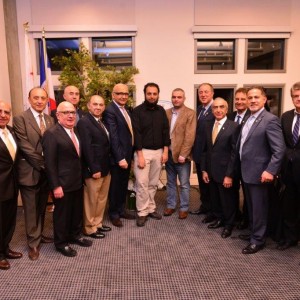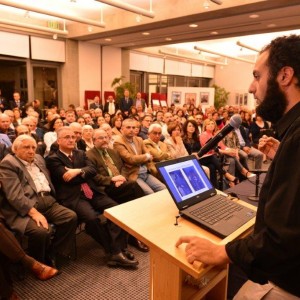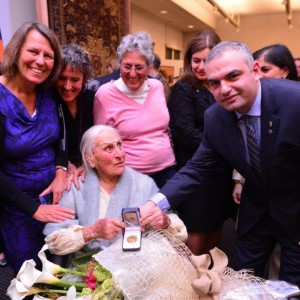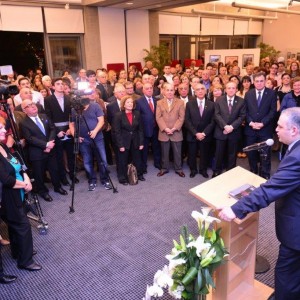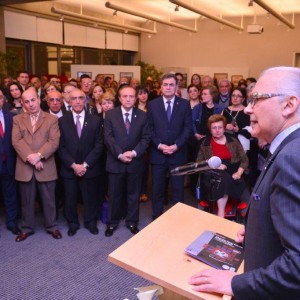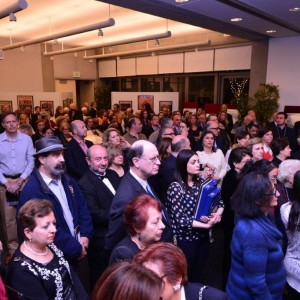June 30, 2015
Exhibition and lectures explore a contemporary dimension of the Armenian Genocide
From April 8 to 10, 2015, the Armenian General Benevolent Union (AGBU) Asbeds Committee hosted a series of events titled “What the World Witnessed a Century Ago” at the Skirball Cultural Center in Los Angeles in conjunction with the Armenian Genocide Museum–Institute in Yerevan.
The series began with an opening reception for an exhibition titled “Armenian Genocide: Frontpage Coverage in the World Press,” based on a book of the same name by Armenian Genocide Museum-Institute director Dr. Hayk Demoyan. The exhibition was on display from April 8 through April 10 and showcased two large rugs woven by Armenian children orphaned during the genocide.
The evening was comprised of speeches by political figures, members of the AGBU Western District leadership and the Armenian community. Remarks were delivered by Congressman Adam Schiff via recorded message; Congressman Brad Sherman; Minister Plenipotentiary Valery Mkrtumyan; keynote speaker Dr. Hayk Demoyan; AGBU Western District Committee chairperson Talin Yacoubian; former AGBU Asbeds chairman Kurken Berksanlar; AGBU Asbeds current chairman Dr. Harout Yaghsezian; master of ceremonies and AGBU Asbeds vice-chair Krikor Yerevanian; and His Eminence Archbishop Hovnan Derderian, who closed the evening.
Of particular note was Congressman Sherman’s speech in which he praised the work carried out by AGBU and presented certificates of commendation and ceremonial flags to Yaghsezian and Demoyan. Demoyan then began his presentation, discussing the process of compiling his book from newspapers in nine countries. The evening also featured a performance by the Armenian Society of Los Angeles Choir under the direction of Maestro Mikael Avetisyan.
The series continued the following day with a lecture by Dr. Uğur Ümit Üngör titled “The Economics of the Armenian Genocide and its Consequences.” Üngör—born in Turkey and raised in the Netherlands—is an associate professor of history at Utrecht University and the Institute for War and Genocide Studies in Amsterdam.
Moderator Kurken Berksanlar introduced Üngör, who began by noting that the Ottoman defeat during the Balkan Wars was the catalyst for the genocide. He continued by analyzing the eight stages of genocide; persecution, elimination of elites, deportations, expropriations, mass killings, forced assimilation, artificial famine and destruction of material culture.
Üngör noted that the Young Turk government established the Committee for Abandoned Property to prevent the sale of property and transfer assets to the state. He explained that the Armenians of Mush, Van and Diyarbekir were particularly wealthy, owning their own businesses and thriving in the wine, copper and silk industries. After the genocide, Üngör examined how Turkish families seized Armenian businesses and lands, amassing wealth in the process.
On the third and final day, over 300 guests gathered for a panel discussion on forcibly Islamized Armenians with His Eminence Archbishop Hovnan Derderian, Primate of the Western Diocese, and Raffi Bedrosyan, writer, activist and advisor to the Zoryan Institute in Canada.
Through slideshows and videos, Bedrosyan presented his work on the Islamized, Turkified and Kurdified Armenians in Diyarbekir. Bedrosyan pointed out that he is inspired by the words of his late friend Hrant Dink: “Let us not focus on the past, but speak of the living.”
“The revival of the St. Giragos Church bears witness to the fact that Armenians lived on those lands,” he said. “Today, the grandchildren of the Kurdified young Armenian girls and boys are speaking up and a number of them are ready to return to their Armenian roots. Are we ready to accept them as Muslim Armenians among us? That is something that only time will tell,” said Bedrosyan.
Archbishop Hovnan Derderian’s presentation focused on the meaning of identity. “What is it that defines an Armenian or any person? Is it faith? Is it language? This is an issue not just for Armenians, but for all people,” said His Eminence. “If we define our belongingness through faith, how does one account for the rampant atheism in Armenia during Soviet times? We overcame that challenge and we will overcome this challenge, too. The hidden Armenians are victims, too. They are the descendants of the orphaned and kidnapped. They are a part of us and our history,” he concluded.
For more information of the AGBU Asbeds Committee, please visit http://agbuwesterndistrict.org/sections/asbeds/

